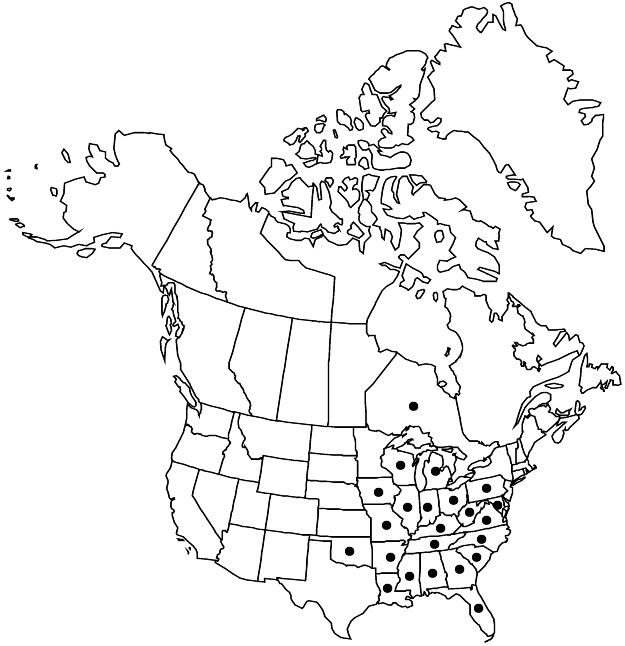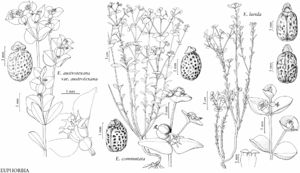Euphorbia commutata
Manual ed. 2, 389. 1856.
Herbs, usually biennial, occasionally annual, with taproot. Stems erect or ascending, decumbent and often branched near base, 10–40 cm, glabrous. Leaves: petiole usually 5–10 mm, 0–1 mm distally; blade usually oblanceolate to obovate, rarely ovate, 5–30 × 3–10 mm, base broadly attenuate, margins entire, apex usually obtuse to rounded, occasionally slightly retuse, surfaces glabrous; venation pinnate, midvein prominent. Cyathial arrangement: terminal pleiochasial branches (2–) 3 (–4), 1–3+ times 2-branched; pleiochasial bracts similar in shape and size to distal leaves; dichasial bracts distinct to basally subconnate, not imbricate, widely ovate, rhombic, or reniform, base cordate, rarely slightly perfoliate, margins entire, apex obtuse to rounded, mucronulate; axillary cymose branches 0–5. Cyathia: peduncle 0.5–1 mm. Involucre campanulate, 1.7–2.5 × 1.5–2.5 mm, glabrous; glands 4, crescent-shaped; 0.6–1 × 0.8–1.5 mm; horns divergent, 0.5–1.1 mm. Staminate flowers 9–15. Pistillate flowers: ovary glabrous; styles 0.9–1.3 mm, 2-fid. Capsules ovoid-globose, 2.5–3.2 × 3 mm, slightly lobed; cocci rounded to ± flattened, smooth, glabrous; columella 1.5–2 mm. Seeds white to gray, broadly oblongelliptic to ovoid or nearly globose, 1.5–2 × 1.3–1.6 mm, strongly small-pitted; caruncle irregularly winglike, conic, 0.6–1 × 0.7–0.9 mm.
Phenology: Flowering and fruiting spring–summer.
Habitat: Bottomland and upland forests, bluffs and ledges, stream banks, glades, rarely fen margins.
Elevation: 50–1000 m.
Distribution

Ont., Ala., Ark., Fla., Ga., Ill., Ind., Iowa, Ky., La., Md., Mich., Miss., Mo., N.C., Ohio, Okla., Pa., S.C., Tenn., Va., W.Va., Wis.
Discussion
Selected References
None.
Lower Taxa
"connate" is not a number. "distinct" is not a number."connate" is not a number. "distinct" is not a number.
